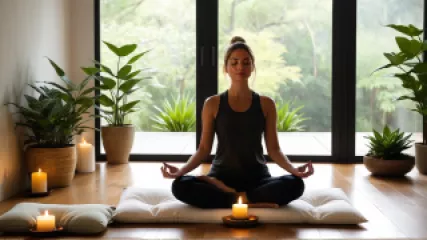The Ultimate Guide to Virtual Mindfulness Retreats
The Ultimate Guide to Virtual Mindfulness Retreats
In our fast-paced, technology-driven world, finding moments of calm and clarity can be a challenge. However, the practice of mindfulness has emerged as a powerful antidote to the stresses and distractions of modern life. Mindfulness, the art of being fully present and engaged in the current moment, has been shown to reduce anxiety, improve focus, and enhance overall well-being. And with the rise of virtual mindfulness retreats, it's never been easier to immerse yourself in this transformative practice, no matter where you are.
In this ultimate guide, we'll explore the world of virtual mindfulness retreats, covering everything from the benefits of this unique approach to mindfulness, to the practical steps you can take to plan and participate in your own virtual retreat. Whether you're a seasoned meditator or new to the practice, this guide will equip you with the knowledge and tools to embark on a deeply enriching, deeply transformative journey towards greater inner peace and balance.
What are Virtual Mindfulness Retreats?
Virtual mindfulness retreats are immersive experiences that allow participants to engage in mindfulness practices and teachings from the comfort of their own homes. These retreats leverage the power of technology to bring together individuals from around the world, creating a shared space for deep introspection, guided meditations, and thoughtful discussions.
Unlike traditional in-person retreats, which often require significant travel and time commitments, virtual retreats offer a more accessible and flexible option. Participants can log in to retreat sessions from their own devices, allowing them to fit this transformative experience into their busy schedules. This accessibility has made virtual mindfulness retreats an increasingly popular choice for those seeking to deepen their mindfulness practice.
At the heart of a virtual mindfulness retreat is a focus on cultivating present-moment awareness. Through a combination of guided meditations, mindfulness teachings, and reflective exercises, participants are invited to let go of the distractions and worries of daily life and turn their attention inward. This immersive experience can lead to profound insights, a greater sense of inner calm, and a renewed appreciation for the simple beauty of the present moment.
The Benefits of Virtual Mindfulness Retreats
Engaging in a virtual mindfulness retreat can offer a wide array of benefits, both for the individual and for the larger community. Here are some of the key advantages of this unique approach to mindfulness practice:
Increased Accessibility
Virtual mindfulness retreats remove many of the logistical barriers that can prevent individuals from attending traditional, in-person retreats. By eliminating the need for extensive travel and time away from work or family commitments, virtual retreats open up the transformative power of mindfulness to a much wider audience. This accessibility can be particularly meaningful for those who live in remote areas, have mobility challenges, or simply have busy schedules that make it difficult to step away for an extended period.
Personalized Experience
Virtual mindfulness retreats often offer a more personalized experience than their in-person counterparts. Participants can engage in the retreat from the comfort of their own homes, surrounded by familiar sights and sounds that can help them feel more at ease and receptive to the practices. Additionally, many virtual retreats incorporate interactive elements, such as breakout rooms for small-group discussions, allowing participants to connect more deeply with the facilitators and fellow attendees.
Ongoing Support
Virtual mindfulness retreats often provide participants with access to ongoing support and resources beyond the retreat itself. This can include access to recorded meditations, follow-up coaching or mentorship, and online communities where participants can continue to connect and support one another. This extended support can be invaluable for helping individuals integrate the insights and practices they've learned during the retreat into their daily lives.
Reduced Environmental Impact
By eliminating the need for extensive travel, virtual mindfulness retreats have a significantly lower environmental impact than their in-person counterparts. This reduced carbon footprint can be a meaningful consideration for those who are mindful of their ecological impact and want to find ways to engage in mindfulness practice that are more sustainable and environmentally responsible.
Preparing for a Virtual Mindfulness Retreat
If you're interested in participating in a virtual mindfulness retreat, there are a few key steps you can take to ensure a transformative and fulfilling experience:
Choose the Right Retreat
With the rise in popularity of virtual mindfulness retreats, there are now countless options to choose from. When selecting a retreat, consider factors such as the facilitator's experience and approach, the specific practices and teachings that will be covered, and the overall retreat structure and schedule. It's also important to ensure that the retreat aligns with your personal goals and interests, whether that's deepening your meditation practice, exploring the philosophical underpinnings of mindfulness, or finding ways to better integrate mindfulness into your daily life.
Prepare Your Space
Creating a comfortable and distraction-free environment is key to getting the most out of a virtual mindfulness retreat. Choose a quiet, private space in your home where you can engage in the retreat activities without interruption. Consider factors such as lighting, temperature, and background noise, and make any necessary adjustments to ensure a serene and inviting atmosphere.
Gather Necessary Supplies
Most virtual mindfulness retreats will provide participants with a list of recommended supplies, which may include items such as a meditation cushion or mat, a journal and pen, and any specific materials needed for the retreat activities. Make sure to have these items on hand before the retreat begins, so you can fully immerse yourself in the experience without interruption.
Prioritize Self-Care
Engaging in a virtual mindfulness retreat can be a deeply transformative experience, but it can also be emotionally and mentally taxing. Make sure to prioritize self-care throughout the retreat, including getting enough rest, staying hydrated, and taking breaks as needed. This will help you approach the practices and teachings with energy, focus, and an open heart.
Embrace the Journey
Mindfulness is a practice, not a destination, and the journey of a virtual mindfulness retreat is as important as the destination. Approach the experience with a sense of curiosity, compassion, and a willingness to let go of preconceptions or expectations. Trust the process, and be open to the insights and transformations that may arise.
What to Expect During a Virtual Mindfulness Retreat
The structure and content of virtual mindfulness retreats can vary widely, but there are some common elements that you can typically expect:
Guided Meditations
At the heart of most virtual mindfulness retreats are guided meditations, led by experienced facilitators. These meditations may focus on a variety of practices, such as breath awareness, body scans, loving-kindness (metta), or contemplation of impermanence. The guided instruction can be particularly helpful for those new to meditation, or for experienced practitioners looking to deepen their practice.
Mindfulness Teachings
In addition to the meditation sessions, virtual mindfulness retreats often include presentations and discussions on the philosophical and practical aspects of mindfulness. Facilitators may delve into the rich history and cultural context of mindfulness, explore the latest scientific research on its benefits, or offer insights and strategies for integrating mindfulness into daily life.
Reflective Exercises
Many virtual mindfulness retreats incorporate reflective exercises and journaling activities, inviting participants to explore their own experiences, insights, and personal growth. These exercises can help deepen the integration of the retreat's teachings and provide a means for participants to process and integrate their experiences.
Breakout Sessions
To foster deeper connections and facilitate more intimate discussions, virtual mindfulness retreats often include breakout sessions in smaller groups. These breakout rooms allow participants to share their reflections, ask questions, and engage in meaningful dialogues with fellow attendees and retreat facilitators.
Mindful Movement
Some virtual mindfulness retreats may also incorporate gentle, mindful movement practices, such as yoga, tai chi, or conscious walking. These practices can help participants cultivate a deeper embodied awareness and integrate the principles of mindfulness into physical expression.
Closing Ceremonies
Virtual mindfulness retreats often conclude with a closing ceremony or ritual, providing a sense of completion and transition. This may involve a final guided meditation, sharing of insights and gratitude, or a call to continue the mindfulness journey beyond the retreat.
Integrating Virtual Mindfulness Retreats into Your Life
The true power of a virtual mindfulness retreat lies in its ability to inspire lasting transformation and integration into daily life. Here are some strategies for ensuring that the insights and practices you've gained during the retreat continue to nourish and support you long after the retreat has ended:
Establish a Regular Mindfulness Practice
One of the most effective ways to integrate the lessons of a virtual mindfulness retreat is to establish a regular, ongoing practice. This may involve setting aside a dedicated time each day for meditation, incorporating mindful movement into your routine, or simply pausing throughout the day to reconnect with your breath and the present moment.
Cultivate a Mindful Mindset
Beyond formal practice, you can also work to cultivate a more mindful mindset in your daily life. This may involve being more attuned to your thoughts, emotions, and physical sensations, practicing non-judgmental observation, and finding moments of pause and presence amidst the busyness of your day.
Connect with a Community
Many virtual mindfulness retreats offer opportunities to connect with a community of like-minded individuals, either through online platforms or local in-person gatherings. Maintaining these connections can provide ongoing support, accountability, and a sense of shared purpose as you continue your mindfulness journey.
Explore Additional Resources
To deepen your understanding and practice of mindfulness, consider exploring additional resources, such as books, podcasts, or online courses. These supplementary materials can help reinforce the lessons you've learned during the virtual retreat and provide new perspectives and techniques to integrate into your practice.
Be Patient and Compassionate
Cultivating a consistent mindfulness practice and integrating its principles into daily life can be a lifelong journey. Approach this process with patience, self-compassion, and a willingness to explore and experiment. Celebrate your successes, learn from your challenges, and trust that each step you take will bring you closer to a more balanced, fulfilling, and mindful way of being.
Conclusion
Virtual mindfulness retreats offer a unique and transformative opportunity to deepen your practice, connect with a supportive community, and find greater peace and balance in your life. By embracing the accessibility, personalization, and ongoing support that these retreats provide, you can unlock the profound benefits of mindfulness and embark on a journey of self-discovery and growth.
Whether you're a seasoned meditator or new to the practice, this ultimate guide has equipped you with the knowledge and tools to plan and participate in a virtual mindfulness retreat that aligns with your personal goals and needs. So take the first step, and get ready to embark on a life-changing journey towards greater mindfulness, focus, and inner calm.
Remember, the key to integrating the lessons of a virtual mindfulness retreat is to approach the process with patience, self-compassion, and a willingness to explore. Embrace the journey, trust the process, and let the transformative power of mindfulness guide you towards a more balanced, fulfilling, and mindful way of being.






